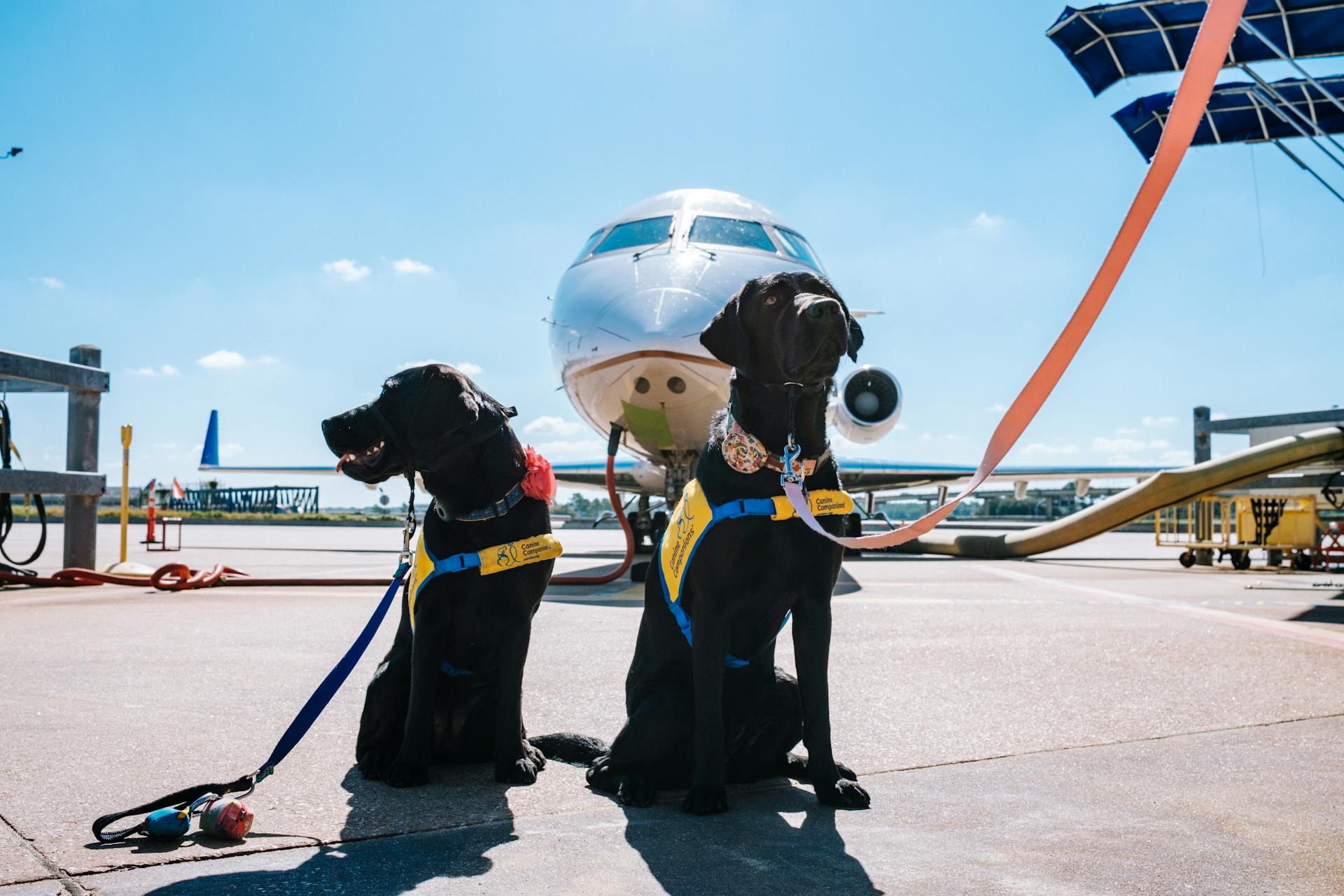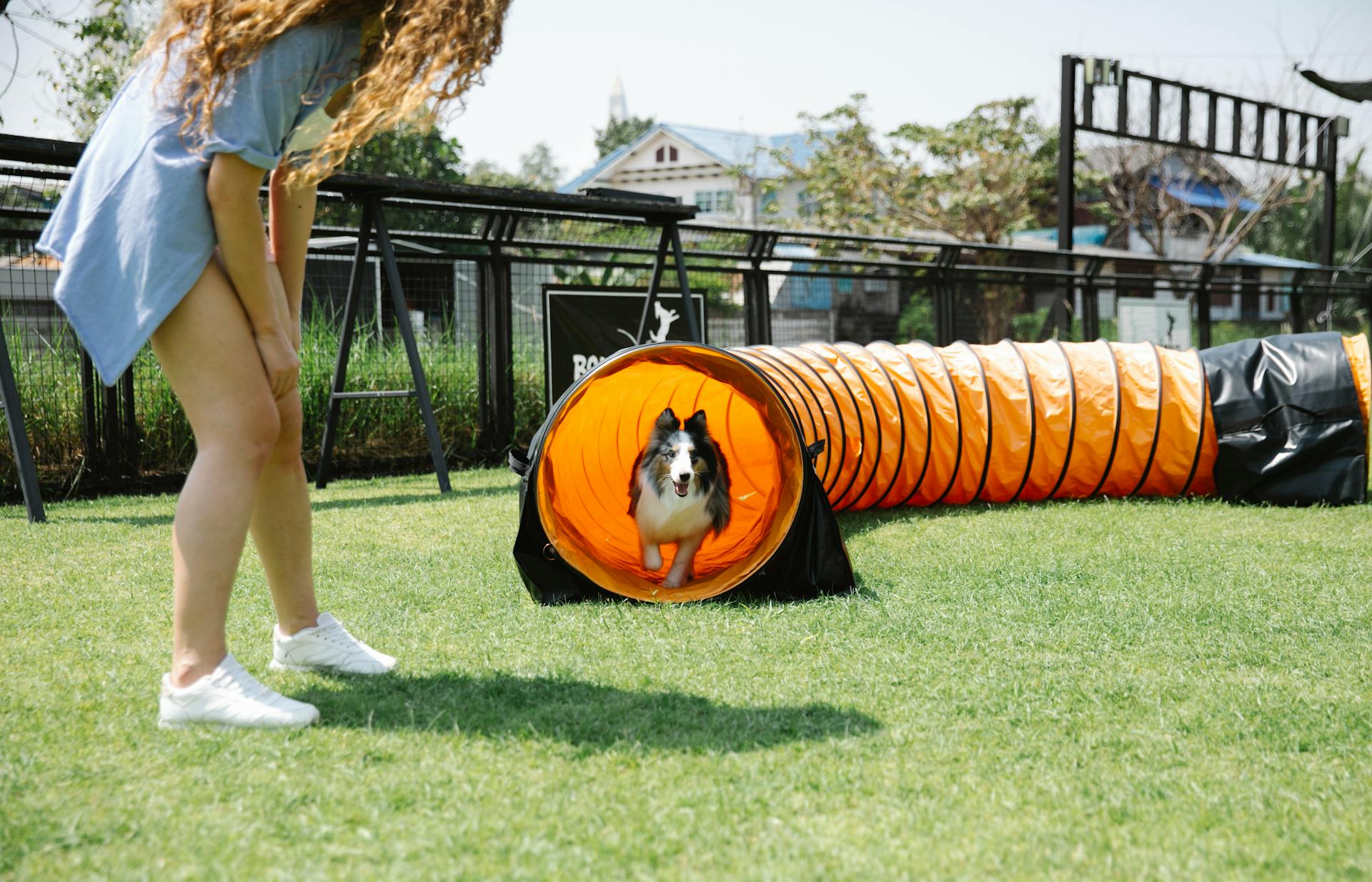
Service dogs are more than just pets, they're highly trained assistants that can make a huge difference in people's lives. They can help individuals with various needs, from mobility and balance issues to conditions like diabetes and seizures.
According to studies, service dogs can reduce stress and anxiety in their owners, which is especially important for people with mental health conditions. A study found that service dogs can decrease cortisol levels and increase feelings of calmness.
Service dogs can also provide physical support and assistance, such as opening doors, picking up items, and providing balance. This can be a game-changer for people with mobility issues, allowing them to live more independently.
In addition to their physical and emotional support, service dogs can also detect changes in their owner's health, such as low blood sugar or an impending seizure. This early detection can be lifesaving, giving the owner and their medical team valuable time to respond.
Discover more: Mobility Service Dogs
Service Dog Types
Guide dogs are trained to assist individuals who are blind or have low vision, helping them navigate through public spaces.
Mobility assistance dogs are designed to support people with physical disabilities, such as paralysis or multiple sclerosis, by providing balance and support.
Seizure response dogs are trained to detect and respond to seizures in individuals with epilepsy, often providing a safe space for them to recover.
Psychiatric service dogs are specifically trained to support individuals with mental health conditions, such as post-traumatic stress disorder (PTSD) or depression, by providing emotional comfort and stability.
Hearing dogs are trained to assist individuals who are deaf or hard of hearing, alerting them to important sounds like doorbells or smoke alarms.
You might like: Are Esa Dogs Service Dogs
Service Dog Breeds
Service dogs come in various breeds, each with unique characteristics that make them suitable for specific tasks. The most common breeds used as service dogs share certain key characteristics, including a desire to work, a calm demeanor, intelligence, a friendly disposition, and a loving disposition.
A different take: What Dogs Are the Best Service Dogs
Dogs with a strong sense of smell, such as Labradors and Golden Retrievers, are often used as service dogs. These breeds have a sense of smell that's 10,000 to 100,000 times better than humans. Their ability to detect scents makes them ideal for tasks like detecting blood sugar variations or alerting owners to important sounds.
Labradors, in particular, are popular as service dogs due to their intelligence, loyalty, and high energy levels. They're often used as guide dogs, hearing dogs, and mobility assistance dogs. According to Canine Companions, their breeding program prioritizes temperament, trainability, health, and physical attributes to produce the best possible service dogs.
Some service dog breeds are better suited for specific tasks. For example, larger breeds like Great Danes and Bernese Mountain Dogs are ideal for mobility assistance due to their height and strength. On the other hand, smaller breeds like Poodles and Pomeranians can excel as hearing dogs or alerting dogs.
Here are some of the most common breeds used as service dogs:
- Labradors (American and English)
- Golden Retrievers
- German Shepherds
- Poodles
- Boxers
- Great Danes
- Border Collies
- Bernese Mountain Dogs
- Pomeranians
- Portuguese Water Dogs
Regardless of breed, the best service dogs are handler-focused, desensitized to distractions, and highly trained to perform specific tasks. They're attentive and responsive to their owners while working, and they're not easily diverted from their tasks at home or in public.
Service Dog Training
Service dog training is a crucial aspect of having a service dog. The ADA doesn't require service dogs to be professionally trained, and individuals with disabilities have the right to train their own service dogs.
A service dog candidate should be calm, especially in unfamiliar settings, and be alert but not reactive. They should also have a willingness to please and be able to learn and retain information. Socialization is key, so the dog should be capable of being socialized to many different situations and environments. Reliable performance of repetitive tasks is also essential.
To start training, work with your candidate dog on foundation skills like house training, which includes eliminating waste on command in different locations. The AKC Canine Good Citizen program can provide guidelines and benchmarks for foundation skills, or you can use the "Confident Puppy" e-learning course.
Under ADA rules, in situations where it's not obvious that a dog is a service animal, only two questions may be asked: Is the dog a service animal required because of a disability? What work or task has the dog been trained to perform?
Explore further: Dog Work
The reply to the second question must affirm that the service dog has been trained to take specific action when needed to assist the person with a disability. This is crucial, as it ensures the service dog is performing the work or tasks it's been trained for.
Here are the key characteristics of a service dog candidate:
- Be calm, especially in unfamiliar settings
- Be alert, but not reactive
- Have a willingness to please
- Be able to learn and retain information
- Be capable of being socialized to many different situations and environments
- Be reliable in performing repetitive tasks
Service Dog Benefits
Service dogs can be a game-changer for individuals with disabilities, and the VA provides some amazing benefits to support them.
The VA distinguishes between service animals that "perform tasks" and animals used for emotional support, and with approval, veterans with physical disabilities may qualify to receive a service dog or guide dog through the VA.
Service dogs can be trained to assist with a wide range of tasks, including picking up items, guiding individuals with vision problems, and helping those who fall or lose balance easily.
To receive benefits, a dog must be received from an Assistance Dogs International (ADI) or International Guide Dog Federation (IGDF) accredited service dog organization.
Take a look at this: Laws for Service Dogs
Mobility
Mobility assistance dogs are a type of service dog that helps individuals with physical disabilities perform everyday tasks. They can be trained to retrieve objects, open doors, press automatic door buttons, and turn on lights.
Mobility assistance dogs are often partnered with people who have conditions such as spinal cord injuries, brain injuries, muscular dystrophy, arthritis, or cerebral palsy. Some of these dogs are specifically trained to brace their owners with balance issues, requiring a minimum weight of 55 pounds.
These dogs typically wear specially-fitted harnesses to assist their owners. Some mobility assistance dogs specialize in helping owners in wheelchairs, retrieving objects, opening doors, and assisting with transfers to chairs, beds, or bathtubs.
Some examples of tasks that mobility assistance dogs can perform include:
- Retrieving objects
- Opening doors
- Pressing automatic door buttons
- Turning on lights
- Bracing owners with balance issues
- Assisting owners in wheelchairs
These dogs play a vital role in enhancing the independence and quality of life for individuals with physical disabilities.
Hearing
Hearing dogs are trained to assist their deaf and hard-of-hearing partners by alerting them to specific cues.
Common breeds used for hearing dogs include labradors, golden retrievers, cocker spaniels, and poodles (miniature or standard).
These cues include smoke or fire alarms, doorbells, door knocking, phones, alarm clocks, and even the person’s name.
Some owners outfit their hearing dogs in bright orange, but it's not required.
Seizure
Seizure alert dogs are a type of service dog that assist individuals with seizures. These dogs can be trained to provide critical support before, during, and after a seizure.
They can find help for their person or call 911 using a K-9 alert phone. Some seizure alert dogs can even help their partner regain consciousness after a seizure.
These dogs can physically move their person if they have a seizure in an unsafe place, which is a crucial safety feature. They can also use deep pressure stimulation to end their partner's seizure early.
Seizure alert dogs can bring medicine to their person as they come out of a seizure, which is a vital task. While scientists and medical professionals have differing opinions on the matter, seizure alert dogs can be a valuable asset for individuals with seizures.
Intriguing read: Financial Help for Service Dogs
Diabetic Alert
Diabetic alert dogs are a type of service dog specifically trained to alert their owner to potentially-deadly blood sugar highs and lows. They can be trained to alert other people in the household or set off an alarm if their owner needs medical assistance.
Here's an interesting read: How Do Service Dogs Know When to Alert
These dogs can also be equipped with a special K-9 alert phone that allows them to call 911 if they're home alone. This feature provides an added layer of security and peace of mind for owners who live alone.
Diabetic alert dogs are trained to detect changes in their owner's blood sugar levels and alert them to take action. They can be trained to perform tasks such as fetching medication or alerting others to their owner's condition.
Some diabetic alert dogs are even trained to carry emergency protocols in their vests, which can help first responders know how to proceed in case of an emergency. This can be especially important for owners who experience severe hypoglycemia or hyperglycemia.
These dogs are truly lifesavers, providing their owners with a heightened sense of independence and security.
Allergy Detection
Allergy detection dogs can be a lifesaver for people with severe food allergies. They're trained to detect allergens like peanuts, gluten, or eggs, alerting their person before they come into contact with them.
These dogs are often paired with children, who are more likely to have severe allergies than adults. This gives kids more independence and their parents more comfort and security.
Allergy detection dogs wear vests with pockets for medical information and medication. In case of an emergency, the vest has a patch directing responders to check the pockets.
Service Dog Information
Service dogs are trained to assist individuals with disabilities, and they're not just limited to physical disabilities.
Service dogs can be trained to detect and respond to a range of medical conditions, including diabetes, seizures, and low blood pressure.
They can also be trained to assist individuals with mental health conditions, such as post-traumatic stress disorder (PTSD).
Suggestion: Cardiac Service Dogs
Finding a Dog
You can find a service dog through professional training organizations or individuals who specialize in training service dogs. These organizations are located throughout the U.S. and work to train dogs to perform specific skills for a handler's disability.
Professional service dog trainers have high standards for their dogs, and the drop-out rates for service dog candidates can run as high as 50% to 70%. This means that many dogs may not make the cut, but fortunately, there are often long lists of available homes for these dogs.
The cost of training a service dog can be quite high, exceeding $25,000. This includes training for the person with a disability and periodic follow-up training for the dog to ensure working reliability. Some organizations provide service dogs at no cost or offer financial aid to those who need but can't afford a service dog.
If you're a veteran approved for a service animal, you'll need to obtain your service animal through trainers certified by one of two accredited service dog organizations: Assistance Dogs International (ADI) or International Guide Dog Federation (IGDF).
Here are some accredited service animal facilities in Illinois:
- International Guide Dog Federation
- Assistance Dogs International
If you'd like to train your own service dog, you're not required to use a professional trainer. However, it's essential to work with a calm, alert, and willing-to-please dog that can learn and retain information.
Is a Dog in a Vest a Dog?
A dog in a vest is not necessarily a service dog. The ADA doesn't require service dogs to wear vests or display identification. In fact, many dogs that do wear ID vests or tags aren't actual service dogs.
Emotional Support Animals, or ESAs, are a good example of this. They're animals that provide comfort by being with a person, but they're not trained to perform a specific job or task for a person with a disability. As a result, they don't qualify as service dogs under the ADA.
If a dog has been trained to sense an anxiety attack and take action to help, that's a service animal. But if the dog's mere presence provides comfort, that's not considered a service animal.
ESAs and therapy dogs, like those used in pet therapy visits, are not service dogs under the ADA. They don't receive access to public facilities, special housing accommodations, or special cabin access on commercial flights.
For more insights, see: Are Service Animals Only Dogs
Frequently Asked Questions
Do service dogs save lives?
Yes, service dogs can change and save lives every day by providing critical support and assistance to those in need. Their life-changing impact is a testament to the incredible bond between humans and animals.
What is the main purpose of a service dog?
A service dog's main purpose is to assist individuals with disabilities, enhancing their independence and quality of life. They are trained to perform specific tasks to help their owners navigate daily challenges.
Are service dogs really necessary?
Service dogs are life-changing and life-saving animals that bring incredible benefits to their owners, far beyond their medical aid capabilities. Their impact is undeniable, making them a vital and necessary companion for individuals with disabilities.
Sources
- https://udservices.org/blog/types-of-service-dogs/
- https://www.purdue.edu/newsroom/releases/2019/Q1/service-dogs-benefit-the%20well-being-of-their-handlers,-research-shows.html
- https://www.dav.org/get-help-now/veteran-topics-resources/service-animals/
- https://www.akc.org/expert-advice/training/service-dog-training-101/
- https://veterans.illinois.gov/services-benefits/service-animal.html
Featured Images: pexels.com


